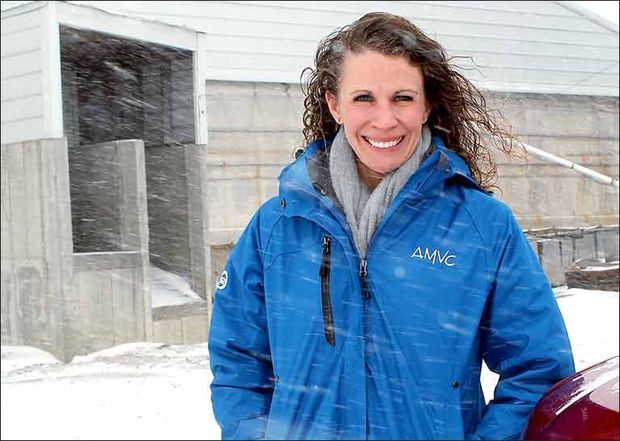posted on Thursday, January 15, 2015 in News
Vet chases down PED
Snowflakes swirl outside her office, but veterinarian Michelle Sprague has more than enough paperwork to keep her out of the elements.
“It’s always there,” says Sprague, a veterinarian with the Audubon-Manning Veterinary Clinic. “And most if it has to do with PED.”
 The porcine epidemic diarrhea virus has kept veterinarians and producers hopping since it was first discovered in the U.S. 20 months ago. Last winter, millions of baby pigs died as the industry sought answers for the virus.
The porcine epidemic diarrhea virus has kept veterinarians and producers hopping since it was first discovered in the U.S. 20 months ago. Last winter, millions of baby pigs died as the industry sought answers for the virus.
“We had one of the very first cases in the U.S., and I sent in a sample to the (Iowa State University Veterinary) diagnostic lab, thinking it was TGE (transmissible gastro enteritis),” says Sprague, who also serves as president of the American Association of Swine Veterinarians (AASV). “The sample tested negative, and I was on the phone daily with them for a week. Something was wrong, and I needed an answer.”
PED was eventually diagnosed by the lab, but to date, there is no cure. In an attempt to better track cases, USDA Secretary Tom Vilsack added PED to the list of diseases veterinarians are required to report to state and federal agencies.
That decision in June 2014 put veterinarians front and center, Sprague says.
“It really didn’t change a lot, other than the increase in paperwork,” she says. “We continued to send samples to the diagnostic lab, and if there is a positive test, they send the information on to the state veterinarian’s office.
“What it did was give us a better of idea where the breaks were occurring. We have much better access to information now.”
Mandatory reporting of PED represented something new for some veterinarians, says Tom Burkgren, a veterinarian and executive director for the AASV.
“It was really a new experience for new veterinarians,” he says. “Those of us who have been around awhile have had this with brucellosis and pseudorabies, but for the newer veterinarians, there were some hurdles to clear.”
Burkgren says reports indicate cases of PED are down significantly this winter compared to a year ago, although he adds it may be too early to proclaim the worst is behind the industry.
“I’m holding my breath a little, but it appears this winter is a much different situation,” he says. “Roughly half of the sow herd was exposed to the virus last year, so we are seeing a better immune response than we did in 2013.”
Burkgren says the industry has worked to improve farm biosecurity and credits that along with sow immunity for fewer outbreaks of PED.
“We’ve really emphasized with our producers that they need to have a tight biosecurity program and be aware of all the different hazards,” he says. “From clothing to cleaning trailers and other risk factors, we are doing a much better job of recognizing risk.”
Veterinarians have been placed at the forefront when it comes to PED reporting, state and national disease surveillance efforts.
“That’s really something we are developing as we go along,” Burkgren says. “The practicing veterinarians are on the front lines, and the National Pork Board has made a concerted effort to work with those veterinarians to put together better information.
“Veterinarians are learning that if they are seeing something different, chances are someone else is seeing it, too. It will help us the next time something comes along.”
Sprague says she believes producers fully understand the importance of biosecurity when it comes to fighting PED and other diseases.
Reporting those cases is helping to build a pool of information that can perhaps limit the damage should another virus come to call, she says.
“We are definitely seeing fewer issues with PED than we did a year ago, primarily, I think, because of sow immunity,” Sprague says. “Biosecurity is also much better, and we have more information that we can access. All of that is going to help us better handle it.”
Photo and Story Credit: Iowa Farmer Today 1/15/15